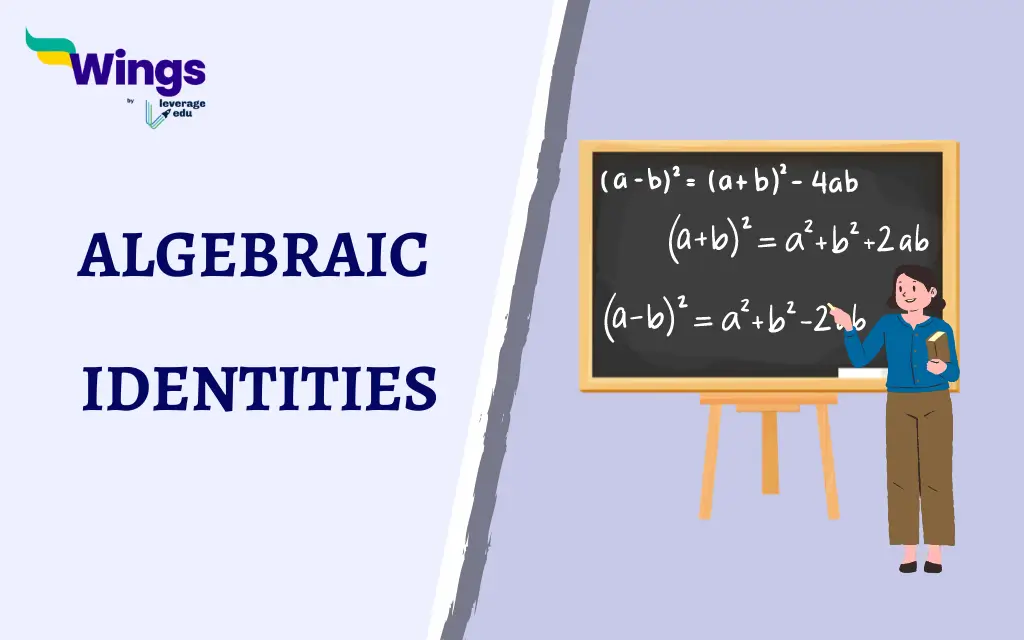Algebraic identities are very important in algebra. They are special equations that stay true no matter what numbers you use for the variables. Furthermore, unlike regular equations with specific answers, these identities always hold true. Additionally, they are like the building blocks of working with expressions and making tough equations simpler for us to solve. Read on to learn more in detail about Algebraic identities, Examples and a Chart of Algebraic identities.
Also Read: Algebra Questions
Examples of Algebraic Identities
In addition, here are some of the most common Algebraic identities:
- Difference of Squares: This rule says that if you square a binomial (which is a sum of two terms), it equals the square of the first term plus twice the product of the first and second terms, minus the square of the second term.
- It looks like this: (a + b)² = a² + 2ab + b²
- Perfect Square Trinomial: This rule talks about expanding a trinomial where the first two terms are perfect squares.
- It says that this type of trinomial can be written as the square of a binomial.
- The rule is: (a + b)² + 2c(a + b) + c² = (a + b + c)²
- Sum-Product Pattern: This rule connects the sum of two numbers to their product.
- Moreover, it says that if you add two numbers and multiply them by their difference, it equals the difference of their squares.
- It is written as: (a + b)(a – b) = a² – b²
- Zero Product Property: This is a basic rule saying that if the product of two things equals zero, then at least one of them must be zero.
- It is written as: ab = 0 => a = 0 or b = 0 (or both)
- Commutative Property: This property says that for addition and multiplication, changing the order doesn’t change the result.
- For Addition: a + b = b + a
- For Multiplication: ab = ba
However, these are just a few examples of algebraic rules used in math.
Also Read: Understanding Set Theory Formulas & Questions
Chart of Algebraic Identities
Furthermore, here is a Chart of Algebraic Identities:
| Chart of Algebraic Identities | |||
| Identity Name | Formula | Description | Example |
| Difference of Squares | (a + b)² = a² + 2ab + b² | Square of a binomial | Expand (x + 2)²: (x + 2)² = x² + (2)(x)(2) + 2² = x² + 4x + 4 |
| Perfect Square Trinomial | (a + b)² + 2c(a + b) + c² = (a + b + c)² | Expansion of a specific trinomial | Expand (x + 1)² + 4(x + 1) + 4: (x + 1)² + 4(x + 1) + 4 = (x + 1 + 2)² = (x + 3)² |
| Sum-Product Pattern | (a + b)(a – b) = a² – b² | Relates sum and product of variables | Find the product of (x + y) and (x – y): (x + y)(x – y) = x² – (y²) |
| Zero Product Property | ab = 0 => a = 0 or b = 0 | If the product is zero, one or both factors must be zero | Solve the equation xy = 0: According to the zero product property, either x = 0 or y = 0 (or both). |
| Commutative Property | a + b = b + a (for addition) | The order does not affect addition | 5 + 3 = 3 + 5 (both equal 8) |
| Commutative Property | ab = ba (for multiplication) | Order does not affect the multiplication | 2 x 7 = 7 x 2 (both equal 14) |
| Difference of Cubes | (a – b)³ = a³ – 3a²b + 3ab² – b³ | Cube of a binomial with a difference | Simplify (x – 2)³: (x – 2)³ = x³ – 3(x²)(2) + 3(x)(2²) – 2³ |
| Binomial Theorem | (a + b)^n = a^n + n(a^(n-1))b + … + b^n (where n is a non-negative integer) | Expansion of a binomial raised to any power | Expand (x + y)⁴ using the binomial theorem. |
How many Algebraic Identities are there?
Algebraic identities are like tools in a toolbox for math. While we cannot exactly count how many there are, there are tons of them! They come from doing different math stuff, like adding, subtracting, multiplying, and dealing with different numbers in equations. However, there are basic ones that are very important. Interestingly, math people are always discovering or making new identities as they explore math more deeply.
Additionally, these identities are useful because they can do a lot of different jobs:
- Making Math Easier: We can use them to simplify complicated math problems by spotting patterns and using these special rules.
- Breaking Down Big Math Problems: Moreover, some identities help us break down big, complicated expressions into smaller, easier ones. This is very helpful when we are trying to solve equations.
- Creating New Math Rules: Whilst playing around with the ones we already know about and putting them together in different ways, we can come up with brand-new rules that help us solve even more challenging problems, over the years.
Related Blogs
I hope this helps! Did you like learning about Algebraic Identities? Keep reading our blogs to learn more about the basic concepts of Maths!
 One app for all your study abroad needs
One app for all your study abroad needs














